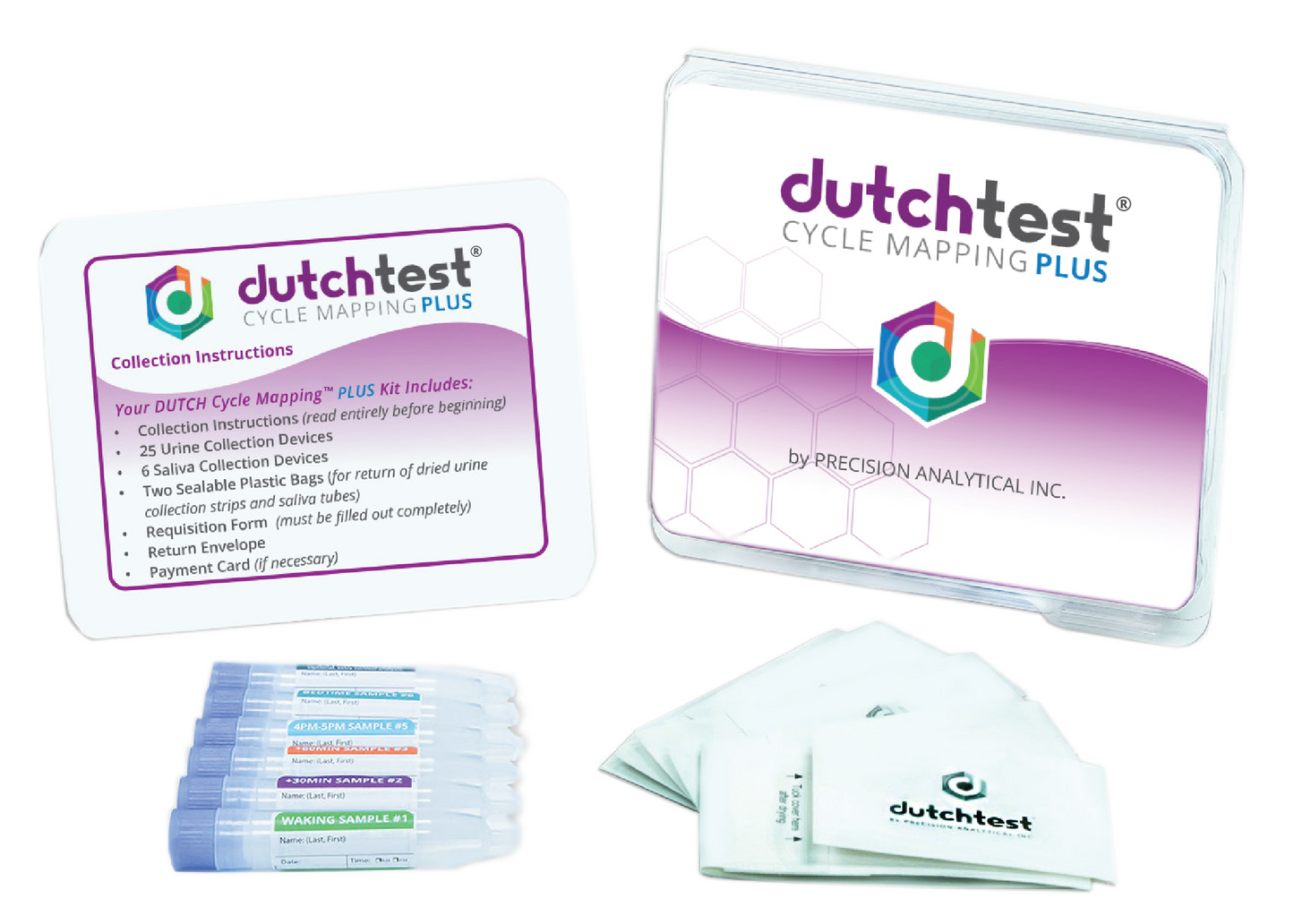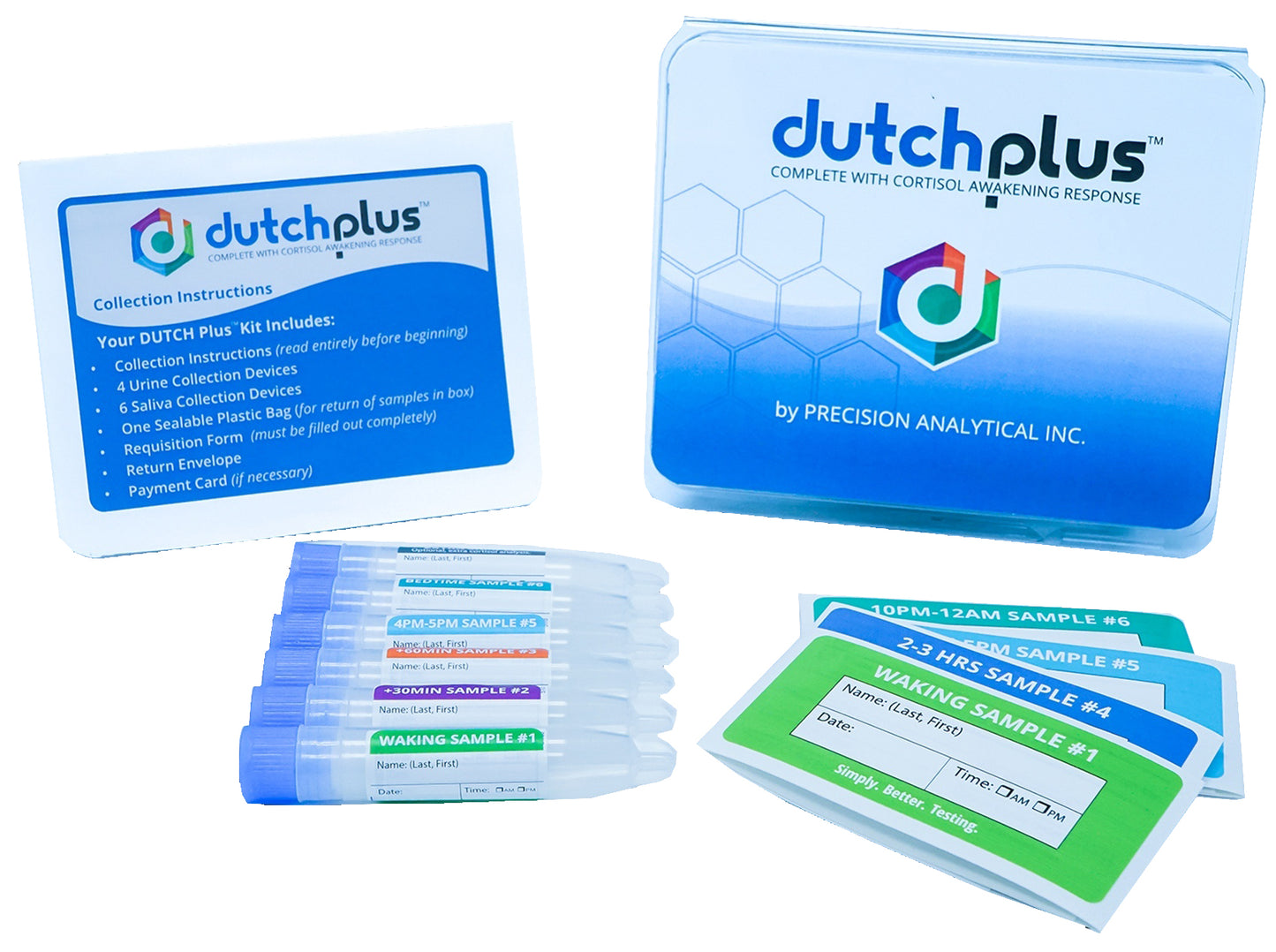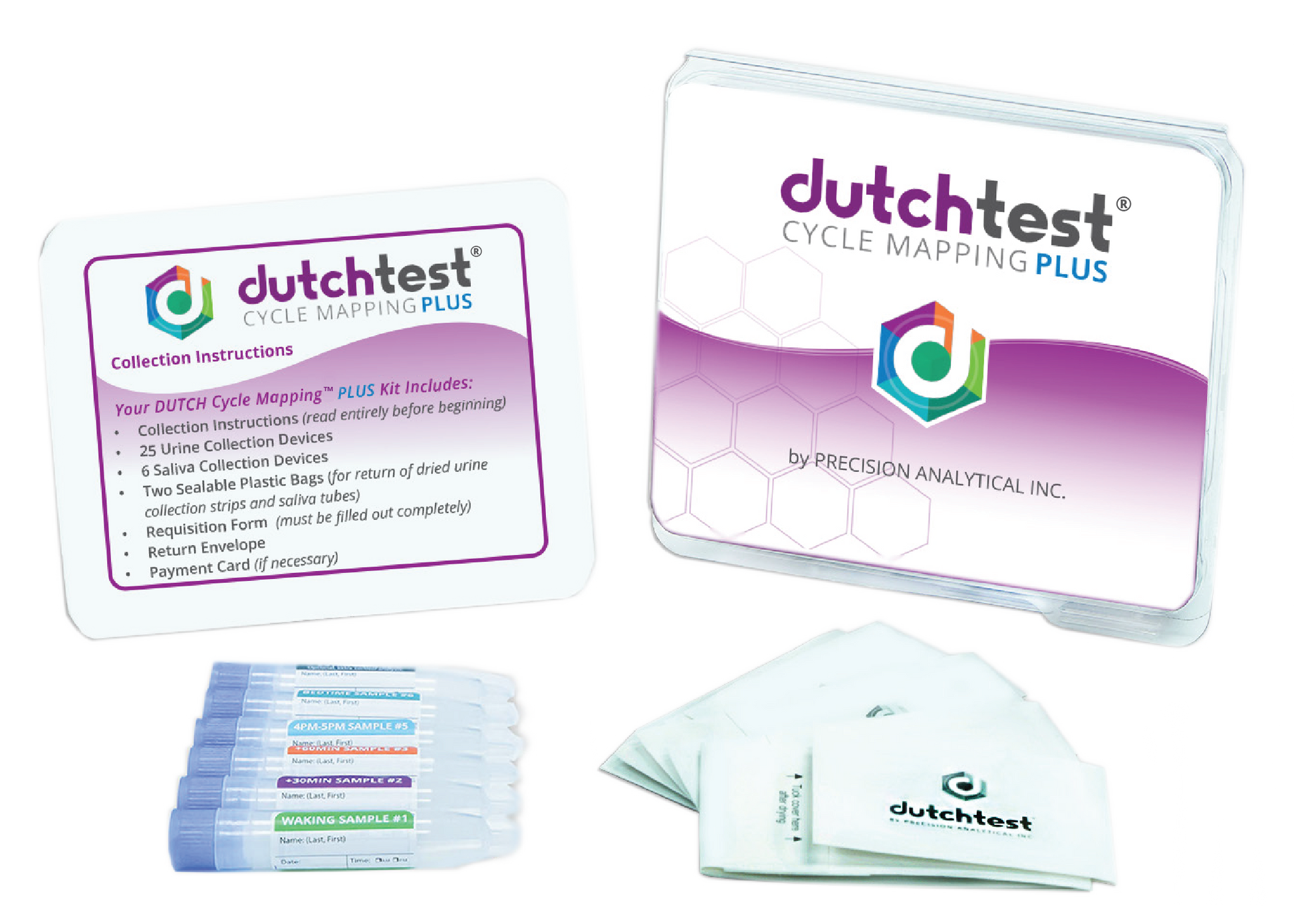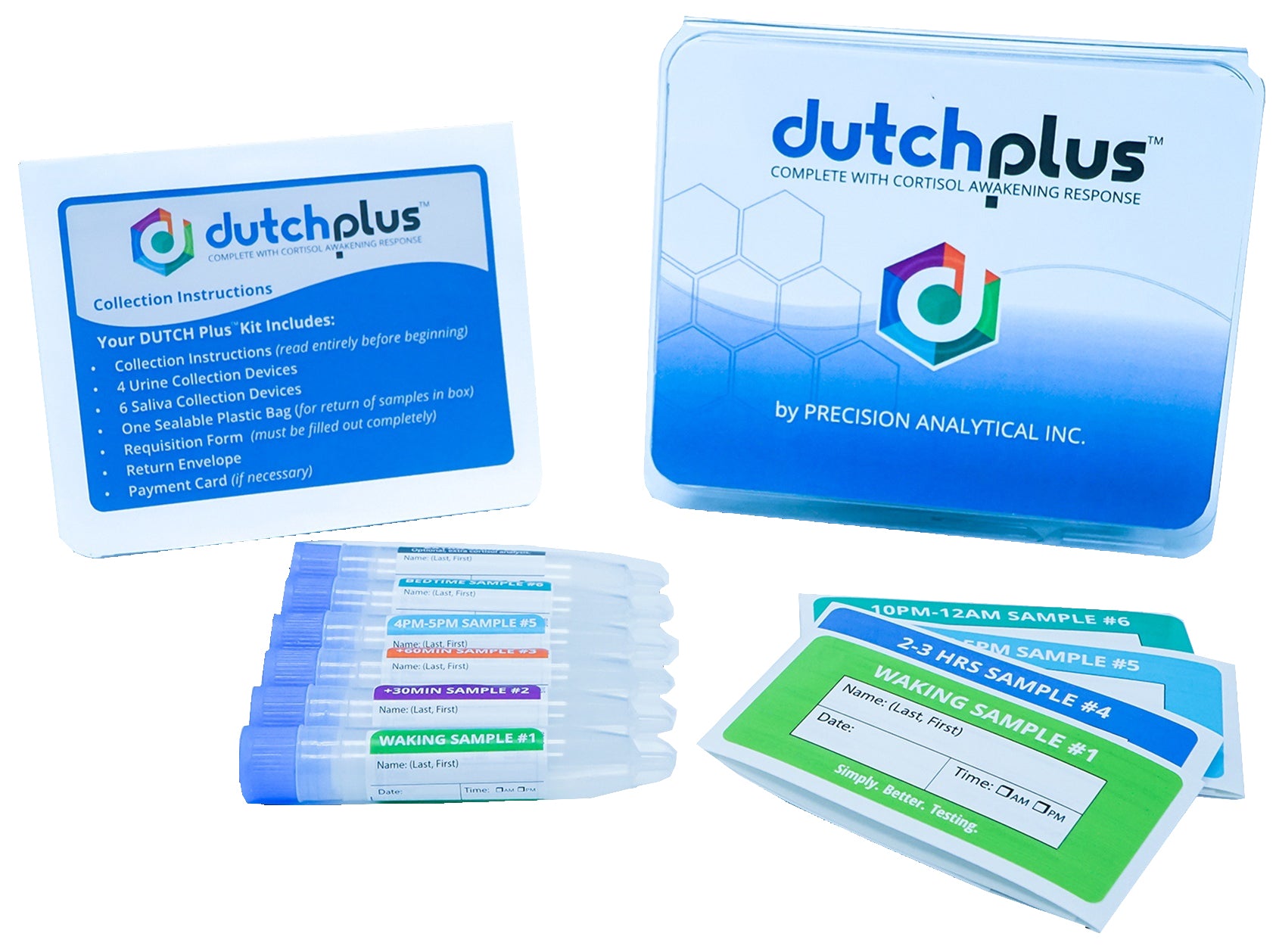Precision Analytical
DUTCH Plus + Cycle Mapping
DUTCH Plus + Cycle Mapping
Couldn't load pickup availability
DUTCH Plus + Cycle Mapping in New Zealand
The DUTCH Plus® adds salivary measurements of the Cortisol Awakening Response (CAR) to the DUTCH Complete™ to bring another important piece of the HPA axis into focus.
The DUTCH Plus® takes hormone testing to a whole new level. In addition to sex hormones and their metabolites, the DUTCH Complete™ looks at the overall diurnal pattern of free cortisol, and the total and distribution of cortisol metabolites. The DUTCH Plus® adds the Cortisol Awakening Response (CAR) to bring another important piece of the HPA-axis into focus.
What is the Cortisol Awakening Response and how do we test for it?
When we open our eyes upon waking, cortisol levels naturally begin to rise by an average of 50%. 30 minutes after waking, cortisol levels will still show this sharp increase. By 60 minutes after waking, cortisol levels have peaked and begin to decline. Measuring this rise and fall of cortisol levels at waking can be used as a “mini stress test”. Research shows that the size of this increase correlates with HPA-axis function, even if the sample measurements are all within range. A quick saturation of saliva swabs upon waking, and at 30 and 60 minutes after waking, provide what is required to assess a patient’s Cortisol Awakening Response.
A low or blunted Cortisol Awakening Response
This can be a result of an underactive HPA axis, excessive psychological burnout, seasonal affective disorder
(SAD), sleep apnea or poor sleep in general, PTSD, chronic fatigue and/or chronic pain. A decreased CAR has also been associated with systemic hypertension, functional GI diseases, postpartum depression, and autoimmune diseases.
An elevated Cortisol Awakening Response
This can be a result of an over-reactive HPA axis, ongoing job-related stress (anticipatory stress for the day), glycemic dysregulation, pain (i.e. waking with painful joints or a migraine), and general depression (not SAD). A recent study1 showed that neither the waking nor post-waking cortisol results correlated to Major Depressive Disorder, but the CAR calculation (the change between the first two samples) did. This measurement of the response to waking has independent clinical value showing dysfunction that may be hidden by current testing options.
Even though a patient may have “normal” free cortisol levels throughout the day, that doesn’t always mean everything is functioning properly. The graph below shows two good examples. A blunted or exaggerated Cortisol Awakening Response (CAR) can appear, even when single samples return “normal” results. The HPA axis might not be appropriately responding when faced with a stressor, even when cortisol levels are fluctuating nicely throughout the day. The “stress” of waking allows us to test the HPA axis in a way that has been independently correlated to clinical outcomes and cannot be assessed by other cortisol tests on the market.
What’s Included in the DUTCH Plus®
The DUTCH Plus® uses four dried urine samples and five saliva samples. These samples are collected over the course of one day, from waking to bed time. The DUTCH Plus® report includes: Metabolites of Estrogens (10, including E1, E2, E3, 2-OHE1, 4-OH-E1, 2-OH-E2, 4-OH-E2, 16-OH-E1, 2-methoxy-E1, 2-methoxy-E2) , Androgens (8, including Testosterone, DHT and DHEA-S), Progesterone (2), Cortisol (3), Melatonin (6OHMS), 8-OHdG, and OATs (6). The diurnal pattern of Free Cortisol and Cortisone are also provided, including the Cortisol Awakening Response.
The DUTCH Cycle Mapping™ maps the progesterone and estrogen pattern throughout the menstrual cycle. It provides the full picture of a woman’s cycle to answer important questions for patients with month-long symptoms, infertility and PCOS. Nine (9) targeted estrogen and progesterone measurements taken throughout the cycle to characterize the follicular, ovulatory and luteal phases.
For some women, testing reproductive hormones (progesterone, estrogen, etc.) on a single day is sufficient. In other scenarios, the clinical picture cannot be properly captured without “mapping” out the hormonal pattern throughout their menstrual cycle.
The expected pattern of hormones shows relatively low estrogen levels early in the cycle, a surge around ovulation and modest levels in the latter third of the cycle (the luteal phase). Progesterone levels, on the other hand, stay relatively low until after ovulation. After ovulation, levels ideally increase (>10-fold) and then drop back down at the end of the cycle. A disruption in this cycle can lead to infertility or hormonal imbalance.
WHEN IS DUTCH CYCLE MAPPING™ RECOMMENDED?
• Women struggling with infertility
• Women with cycling hormones and no menses
• Partial hysterectomy (ovaries intact but no uterus)
• Ablations
• Mirena IUD (no actual menstrual bleeding due to IUD but still has hormonal symptoms)
• Women with irregular cycles
• PCOS
• If the luteal phase shifts from month-to-month
• Not sure when to test due to long or short cycles
• Women whose hormonal symptoms tend to fluctuate throughout the cycle
• PMS, mid-cycle spotting, migraines, etc.
WHEN IS DUTCH CYCLE MAPPING™ NOT NEEDED? (DUTCH COMPLETE™ IS SUFFICIENT)
• Postmenopausal women
• Women on birth control
• Women with cycles that follow the expected pattern
Estrogen and progesterone metabolites for this profile are all tested (9x) by GC-MS/MS. This is the most accurate method for testing urinary reproductive hormones and their metabolites.
Sampling Instructions for DUTCH CYCLE MAPPING
Sampling Instructions for DUTCH PLUS
Irregular Cycle Collection - How to collect your samples
For technical support call: 0800-88-44-33
GENERAL DISCLAIMER
We recommend that you always seek the advice of a qualified health care practitioner regarding any medical or health related diagnosis or treatment before acting on this test information. Nutrisearch does not provide clinical advice on test selection or interpretation of testing for wellness testing to patients, nor does it provide diagnosis, treatment or medical advice. Nutrisearch is not liable to you or anyone else for any loss or negative consequence caused in whole or in part by interpreting, delivering or reporting information through the utilizing of laboratory testing services. In no event shall we be liable to you or any other party for any decisions made or action taken or not taken by you in reliance on such information.
Share




